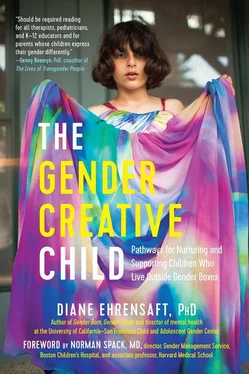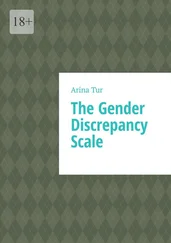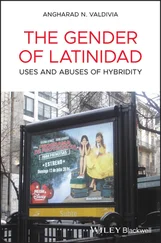I know I’m jumping ahead here into discussions of medical interventions for gender-nonconforming youth, which we will visit later in the book, but imagine for a moment that you are a parent of a gender-nonconforming child. You’re confused about what that means and what you should do about it, and you trust media experts hired by reputable networks to help enlighten you. The Laura Ingrahams of the world not only speak untruths, they leave parents in confusion and shame. Hopefully, Ingraham will someday read this book, then recognize and put an end to the damage she may be inflicting—on children, on parents, on our communities—as she feeds the cancers of transphobia with her myths and accusations. In the meantime, it is important for all of us to remember that in our efforts to create a gender creative life for all of us, the Laura Ingrahams of the world need to be either silenced or reeducated if we are to stop the flow of toxic messages to children that their gender expression is just foolish child’s play or attention-getting behavior. Even more important, we need to get the message across to parents that any efforts to not meet their child’s gender needs is what would count as negligence, lax discipline, or outright abuse.
The Gender Affirmative Model
In 2008, I was interviewed by Alix Spiegel for an NPR radio broadcast on transgender children. The other psychologist featured was Dr. Ken Zucker, who until recently was the head of the child and adolescent gender identity clinic at Toronto’s Centre for Addiction and Mental Health. I spoke of the importance of listening to children and following their lead about their gender identity—it is not for us to say, but for them to tell. Dr. Zucker presented a model for helping young children accept the sex they were assigned at birth, by shaping their behavior in that direction in the hopes of getting them to live comfortably in their own skin (i.e., the skin associated with their genitals). When asked by Spiegel at that time which model was more prevalent among mental health practitioners, I sighed, breathed out a nervous laugh, but responded without a moment’s hesitation, “Oh, his.” If Spiegel were to come back to me now and ask the same question, I am happy to say that I would smile, no sigh, no nervous laugh, and respond without a moment’s hesitation, “Oh, ours.” What do I mean by “ours”?
Many of us have banded across disciplines and across countries to shape what is now known as the gender affirmative model. We have also organized an international gender affirmative consortium under the auspices of Gender Spectrum, open to professionals of all disciplines who work with or advocate for gender-nonconforming and transgender children and youth and share our basic philosophy. Our model stretches and grows as we grow, but the basic premises remain in place:
• Gender variations are not disorders; they are not pathological.
• Gender variations are healthy expressions of infinite possibilities of human gender.
• Gender presentations are diverse and varied across cultures, requiring cultural sensitivity to those variations.
• Gender involves an interweaving of nature, nurture, and culture—no one of these stands alone in shaping gender.
• A person’s gender may be binary; a person’s gender may be fluid or multiple.
• If people suffer from any kind of emotional or psychiatric problem connected to their gender, this is most likely because of negative reactions to them from the outside world.
• If there is gender pathology, we will find it not in the child but in the culture (otherwise known as transphobia). [11] For a thorough, scientific description of the gender affirmative model, I would refer you to M. Hidalgo et al., “The Gender Affirmative Model: What We Know and What We Aim to Learn,” Human Development 56 (2013): 285–90.
In outmoded models of gender treatment, gender health has been understood to be the ability for children to accept their core gender identity (the sex assigned to them on their birth certificate) and conform to the expectations for gender in their culture. In the gender affirmative model, gender health is defined as the opportunity for children to live in the gender that feels most real and/or comfortable. Alternatively, we understand gender health as the ability for children to express gender without experiencing restriction, criticism, or ostracism.
In the gender affirmative model, we say, as I did in my 2008 radio interview, that children are the experts of their own gender self, and, at most, we adults are their translators—striving to understand what they are telling us about their gender in words, actions, feelings, thoughts, and relationships. When it comes to considering medical interventions for youth who desire a gender transition, we measure in stages, not ages. In other words, we do not say that children have to be a minimum of twelve years old to receive puberty blockers that will put a pause on forthcoming body changes; we do not say that youth have to be at least sixteen years old to be considered for cross-sex hormones or hormone replacement therapy (HRT), a term more recently preferred by many, to affirm their transgender self. [12] The term cross-sex hormones is commonly used to refer to the estrogen or testosterone that transgender youth take to align their bodies to their affirmed gender. Some people prefer to use the medical term hormone replacement therapy , which in no way implies that anyone has crossed any sex lines but instead indicates that this person just needs an addition of hormones to solidify their affirmed gender. HRT as a term has its own set of problems, since so many of us—particularly ciswomen of a certain age—associate hormone replacement therapy with the plight of menopausal women in the early twenty-first century, who were told for many years of the benefits of such treatment and then warned that those very treatments might be causing them physical harm. To avoid this terminology conundrum, I have opted to simply use the term hormones whenever possible to refer to the treatment that allows a youth to receive hormones in alignment with their affirmed gender identity.
We rely on the concept of readiness—when children reach Tanner stage II of puberty, when their incipient body changes are in evidence, they are ready to be considered for puberty blockers, whether they are nine or fifteen. When children have been on puberty blockers for four years, are clear about their affirmed gender identity, and are sure they want to go on hormones to complete their gender affirmation, they are ready, whether they are thirteen, fifteen, or eighteen. Age norms, although ostensibly set in concordance with children’s emotional or cognitive maturity, often turn out to be dictated by a particular country’s legal statutes regarding youths’ medical decision-making rights rather than an individual child’s emotional readiness. We also endorse social transitions for prepubertal children who are clear about their gender and communicate to us in no uncertain terms that a happy life for them will be a life in their affirmed gender, not later, but now. They could be ten years old; they could be four years old.
I lay this all out to you in advance, before going into detail about any one of these things, so you can be clear about where I am coming from as I flesh out the full profile of the gender creative child and the world that surrounds that child. I am neither an essentialist—one who says that gender is a given and set at birth or before—nor am I a social constructivist—one who says that gender is just a people-made concept that fluctuates over time. Rather, I am a transactionalist—one who says that nature and nurture crisscross over time in a myriad of ways in the context of each particular culture to create gender as we know it. No doubt some of what we will look at about gender is heavily weighted on the nature end—having to do with the biology of the child. And some of it is heavily weighted on the nurture end—having to do with the social mores of gender and family practices. But like a well-built mobile, every weighted piece is carefully balanced in relationship to every other piece to make the suspended, gracefully flowing gender sculpture that is unique to each person on earth.
Читать дальше












